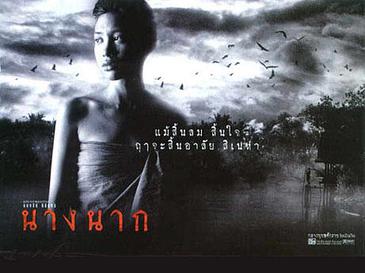
There are many films about the legendary Thai ghost, Nang Nak. I haven't seen too many of them, but I remain partial to Nonzee Nimbutr's 1999 take because of the balance and humanity with which it presents the legend. This isn't The Exorcist or The Exorcism of Emily of Emily Rose. It's done with a significant amount of dignity and a minimum of gore and splatter. Intira Jaroenpura made her debut as the lead in Nimbutr's film, and she's continued to star in an increasing number of films recently, including Pawat Panangkasiri's somewhat controversial Nak Prok (In the Shadow of the Naga).
Thai writer S.P. Somtow did an opera based on the story, premiering in 2003. Nancy Yuen portrayed Mae Naak as a more horrific, vengeful figure during a 2005 revival. Some great clips are up on Youtube at the moment. Personally, I consider Nang Nak one to depict sympathetically, but every artist has their own take. My own poem, Nang Nak, appears in my book On The Other Side Of The Eye, and there's a short story I have about her that is the core of a new collection I'm working on.
Functionally speaking, Nang Nak is what the Thai consider a phi tai ton glom, a woman's ghost who died during childbirth and whose baby also died. As such it is one of the most powerful and fearful types of the ghosts of Thailand. They are not to be angered.
The story of Nang Nak is typically centered near the Prakanong river and a shrine is dedicated to her at Wat Mahabut. The short form of the story is that while waiting for her husband to return from a war on the borders, Nang Nak died giving birth to their child. When he returned from the war, Nang Nak returned from the dead, waiting for him and tried to resume an ordinary life with him. Details vary from that point on, but as in most tales, things don't go quite as planned. To this day, however, the Thai and others love to retell the story and a new film comes out fairly regularly in Thailand, as well as television shows, books, plays and other forms of art.
No comments:
Post a Comment